What is Value Stream Mapping ?
Value-stream mapping is a lean-management method for analyzing the current state and designing a future state for the series of events that take a product or service from its beginning through to the customer with reduced lean wastes as compared to current map. In other words, a value stream focuses on areas of a firm that add value to a product or service, whereas a value chain refers to all of the activities within a company.
The goal is to depict material and information flows across and throughout all Value-Adding Processes required to produce and ship the product to the customer. Value Stream Maps document all of the processes used to produce and ship a product, both Value-Adding and Non-Value-Adding (Waste) processes.
Applications of Value Stream Mapping
Value-stream mapping has supporting methods that are often used in Lean environments to analyze and design flows at the system level (across multiple processes).
Although value-stream mapping is often associated with manufacturing, it is also used in other industries such as:
- Logistics,
- Supply chain,
- Service related industries,
- Healthcare,
- Software development,
- Product development,
- Administrative and office processes.
Value Added vs Non Value Added Time
Most manufacturers try to eliminate all unnecessary production costs and wasted time. This makes their production lines leaner and also makes customers happier. Companies can provide better products at a cheaper price if they run production operations smoothly and efficiently. One way managers measure the efficiency of the production line is by looking at the cycle time.
Cycle time measures the amount of time it takes to produce a product. Cycle time includes process time, inspection time, move time, and wait time. All of these processes are part of producing one product. Inspection time, move time, and wait time are considered to be non-value adding time processes. Inspecting a computer for flaws or moving it to the loading dock does not improve the computer. In other words, these processes don’t add value to the product.
Value added time is made up of processes that improve products. The only value added time process in the cycle time example is the process time. This is the amount of time it takes to actually produce the product. Obviously, production time is a value added time because it creates a product from raw materials. The product is improved at the end of the process time.
Most of the time when a process is considered a value added time process it is only considered from the customer’s point of view. What I mean by that is customers don’t care if the company has to spend time packaging products or spend money storing them. Neither of these processes makes the product any better in the customer’s eyes.
Example Electronic Widget
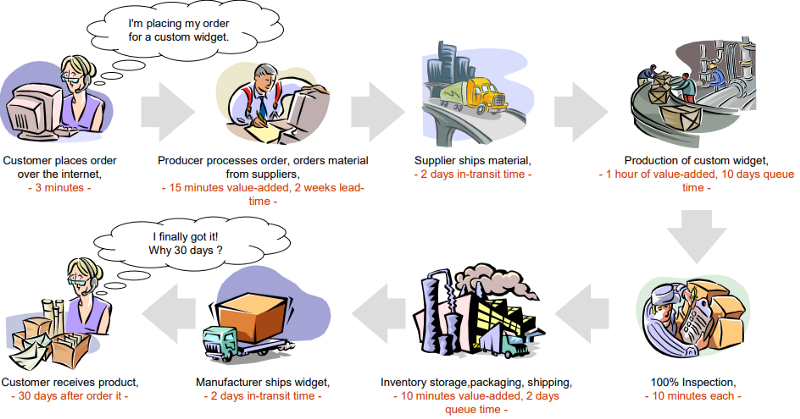
Value-Added Time:
3 Mins (Place Order)+ 15 Mins (Process Order) + 1 Hour (Product of Widget) + 10 Mins (Packing) = 1 Hours 25 Mins
Elapsed Time from Order to Delivery : 30 Days
Type of Waste
Daniel T. Jones (1995) identifies seven commonly accepted types of waste. These terms are updated from the Toyota production system (TPS)’s original nomenclature:
- Faster-than-necessary pace: creating too much of a good or service that damages production flow, quality, and productivity. Previously referred to as overproduction, and leads to storage and lead time waste.
- Waiting: any time goods are not being transported or worked on.
- Conveyance: the process by which goods are moved around. Previously referred to as transport, and includes double-handling and excessive movement.
- Processing: an overly complex solution for a simple procedure. Previously referred to as inappropriate processing, and includes unsafe production. This typically leads to poor layout and communication, and unnecessary motion.
- Excess Stock: an overabundance of inventory which results in greater lead times, increased difficulty identifying problems, and significant storage costs. Previously referred to as unnecessary inventory.
- Unnecessary motion: ergonomic waste that requires employees to use excess energy such as picking up objects, bending, or stretching. Previously referred to as unnecessary movements, and usually avoidable.
- Correction of mistakes: any cost associated with defects or the resources required to correct them.
Looking For Value Stream Mapping Software?
I recommend a good tool for creating (VSM) diagram. Visual Paradigm Online makes it easy and quick to create professional value stream mapping. The value stream mapping tool comes with a rich set of value stream mapping symbols. Combining with the drag-and-drop VSM editor and powerful feature set, you can create professional value stream maps easily.
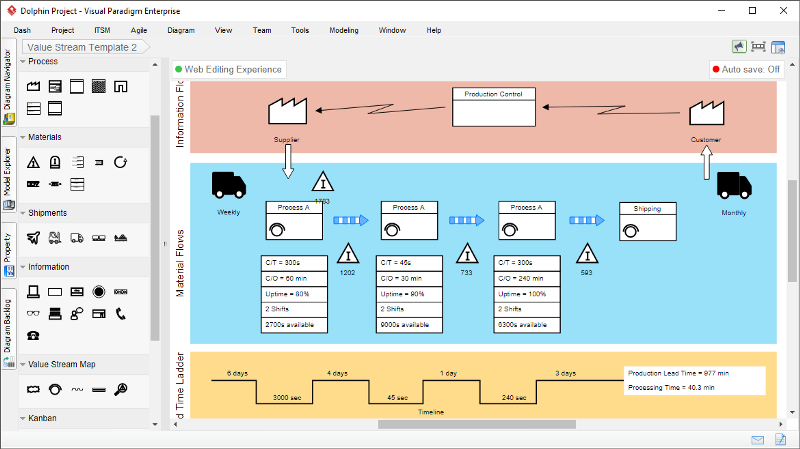
Simple editing
- Develop value stream mapping easily with drag-and-drop and mouse clicks. Use alignment guide to position shapes precisely when dragging.
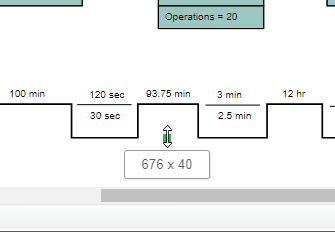
Easy collaboration
- Team members can draw collaboratively and simultaneously. They can even edit on the same diagram without ruining others’ work.

Multiple output formats
- Share your diagrams with co-workers and friends by exporting diagrams into images (PNG, JPG, SVG, GIF) or PDF.
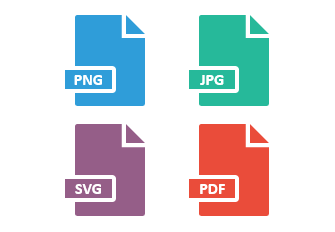
MS OFFICE INTEGRATION
- Instead of copying and pasting static images, embed your value stream mapping in MS applications. Word, PowerPoint, OneNote and Outlook are supported.
DRAW WITH YOUR OWN SHAPES
- Create a palette consisting of your stencils in image formats (e.g. SVG, JPG, PNG, etc) and use them in your design.
Create Visual Stream Mapping Diagram
VP Online offers a rich set of professionally-designed value stream mapping templates that make you instantly productive. Following are few of them. Click on a template to view it, or click Edit to start editing — no prior registration required!
More value stream templates are available in the value stream mapping tool.
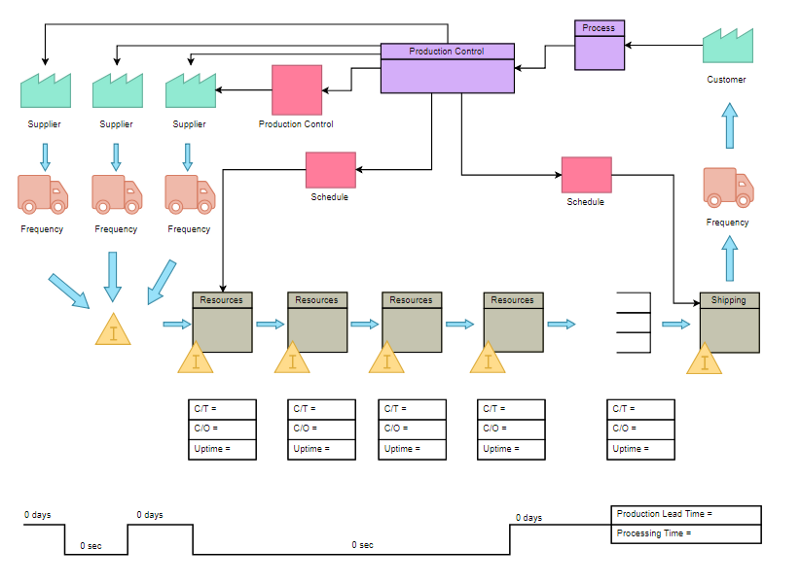
(Click and Edit VSM Instantly)
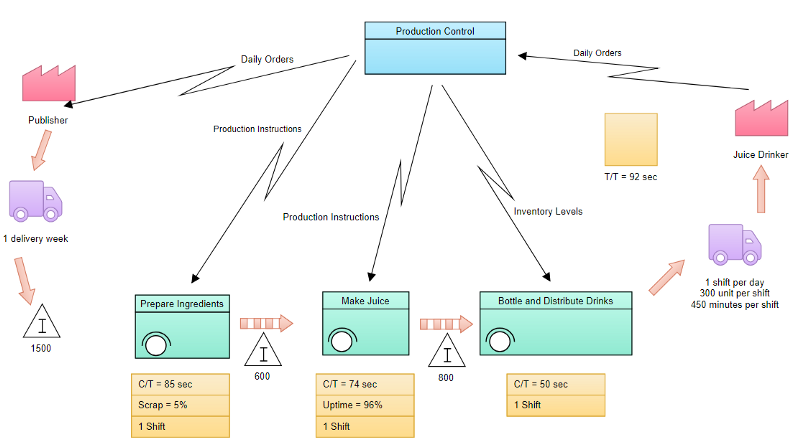
(Click and Edit VSM Instantly)
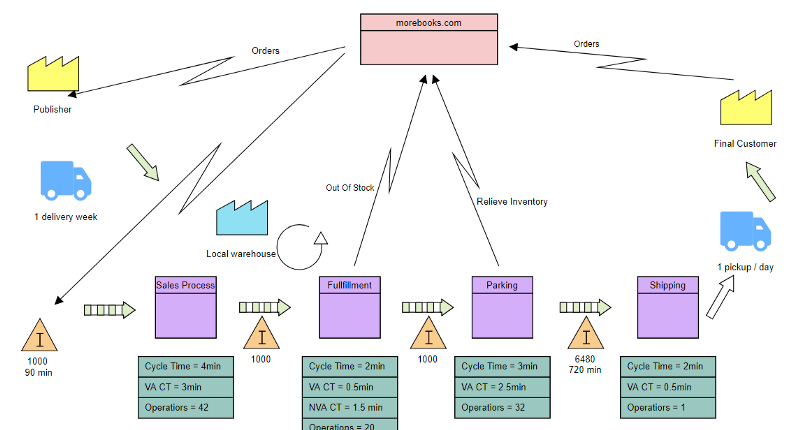
(Click and Edit VSM Instantly)
More Value Stream Mapping Examples in Gallery (Instantly edit and open)

